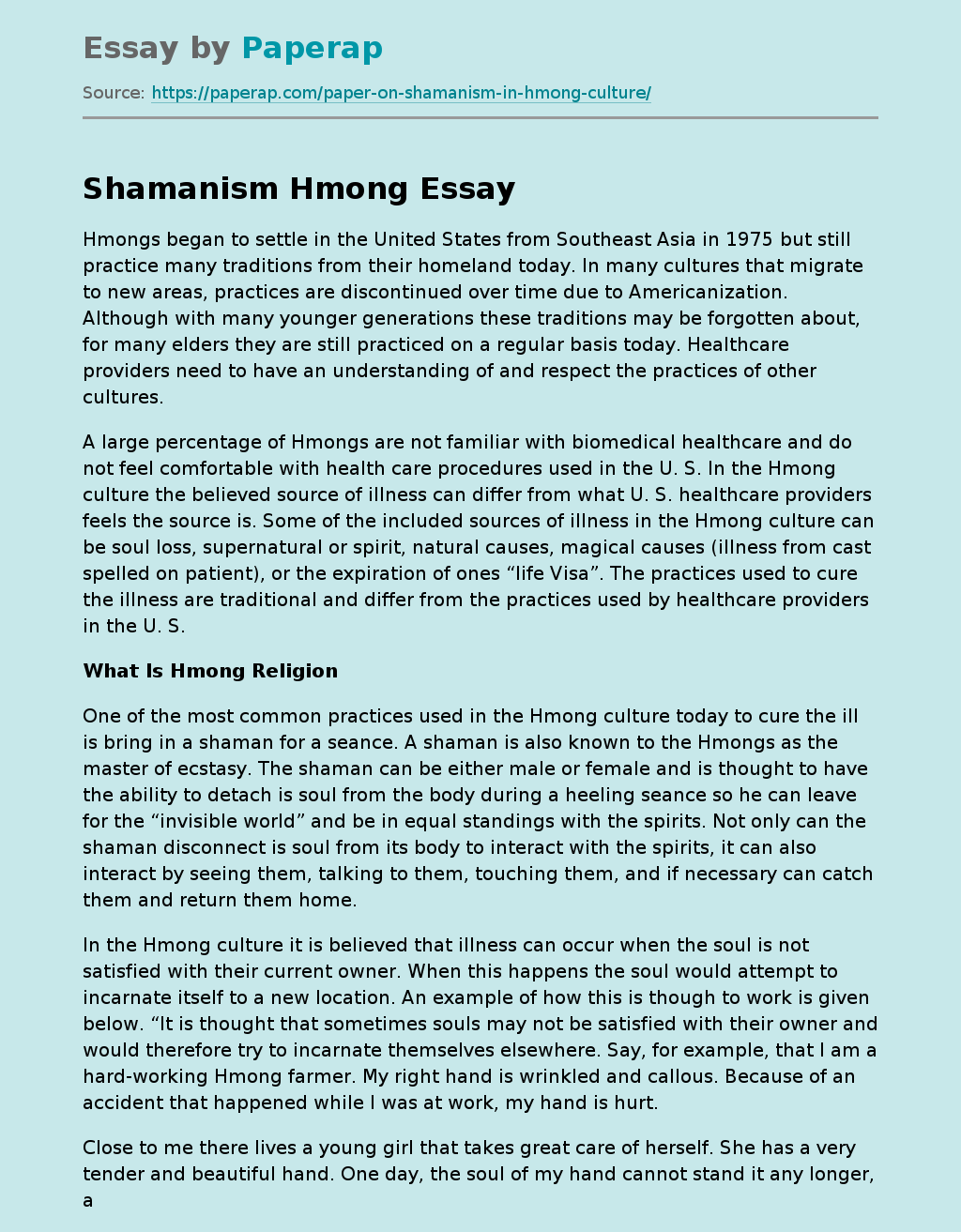What Is the Hmong Religion
The following sample essay is dedicated to the topic – what is the Hmong religion and shamanism. Read the introduction, body and conclusion of the essay, scroll down.
Hmongs began to settle in the United States from Southeast Asia in 1975 but still practice many traditions from their homeland today. In many cultures that migrate to new areas, practices are discontinued over time due to Americanization. Although with many younger generations these traditions may be forgotten about, for many elders they are still practiced on a regular basis today.
Healthcare providers need to have an understanding of and respect the practices of other cultures.
A large percentage of Hmongs are not familiar with biomedical healthcare and do not feel comfortable with health care procedures used in the U. S. In the Hmong culture the believed source of illness can differ from what U. S. healthcare providers feels the source is. Some of the included sources of illness in the Hmong culture can be soul loss, supernatural or spirit, natural causes, magical causes (illness from cast spelled on patient), or the expiration of ones “life Visa”.
The practices used to cure the illness are traditional and differ from the practices used by healthcare providers in the U. S.
What Is Hmong Religion
One of the most common practices used in the Hmong culture today to cure the ill is bring in a shaman for a seance. A shaman is also known to the Hmongs as the master of ecstasy. The shaman can be either male or female and is thought to have the ability to detach is soul from the body during a heeling seance so he can leave for the “invisible world” and be in equal standings with the spirits.
Not only can the shaman disconnect is soul from its body to interact with the spirits, it can also interact by seeing them, talking to them, touching them, and if necessary can catch them and return them home.
In the Hmong culture it is believed that illness can occur when the soul is not satisfied with their current owner. When this happens the soul would attempt to incarnate itself to a new location. An example of how this is though to work is given below. “It is thought that sometimes souls may not be satisfied with their owner and would therefore try to incarnate themselves elsewhere. Say, for example, that I am a hard-working Hmong farmer. My right hand is wrinkled and callous. Because of an accident that happened while I was at work, my hand is hurt.
Close to me there lives a young girl that takes great care of herself. She has a very tender and beautiful hand. One day, the soul of my hand cannot stand it any longer, and it ” falls,” as the Hmong would say. By this it must be understood that the soul of the farmer’s hand escapes in order to reincarnate itself in the girl’s hand that is so soft. “ When the soul successfully leaves its owner the body is left mutilated and sick which is why a shaman is called in to contact the spirit and heal the body by bringing back the soul potentially by using force.
Hmong people typically belong to a specific clan and for each specific clan they have their own shaman which has been chosen by the spirits. The shaman heals the patient by draping the ills face with a black cloth and leaves their body to enter the invisible world. While in the invisible world the shaman may ask for specific animals to be sacrificed in order to satisfy the spirit who are accountable for the evil and illness. When the shaman is finished satisfying and retrieving the lost soul health is then restored to the patient.
The healing process needs to be done in very correct and specific ways in the Hmong culture and before they can seek further medical attention the shaman needs to be brought in to seek the soul first. The process of using a Shaman to restore healing does not only reconnect the soul with its owner it also restores connections that were lost during the illness between the patient, family, and community. Being that many Hmong people living in the Untied States today still practice healing with a Shaman it is important that health care workers understanding what and how a Shaman works.
When a Hmong person comes in to seek medical attention or is taken unknowingly (is concounsious or unstable and is brought in by another person or family member) it is important to understand that before a procedure or given medications a Shaman may be needed before this process can happen. In their culture in order to a person to heal the Shaman needs to find the lost soul or health will never be restored. Although this might sound strange or be aggravating to many biohealth believers being respectful and understanding is key to winning their trust.
A majority of Hmong people do not feel comfortable seeking health care at hospitals and clinics in the U. S. because the practices vastly differ from the practices in their home land. So as a healthcare professional do your research and have an understanding about cultures other than your own. The Shaman is a necessity in order to heal a person in their beliefs and if medical attention needs to be carried out bring in a Shaman and let them first heal the patient by their beliefs so that the needed surgery or care can take place.
What Is the Hmong Religion. (2019, Dec 05). Retrieved from https://paperap.com/paper-on-shamanism-in-hmong-culture/

